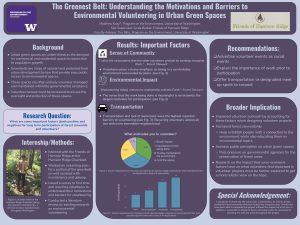THE GREENEST BELT: UNDERSTANDING THE MOTIVATIONS AND BARRIERS TO ENVIRONMENTAL VOLUNTEERING IN URBAN GREEN SPACES
Urban green spaces play a vital role in an increasingly industrialized world by acting as natural carbon sinks to reduce air pollution while also allowing individuals in the community to have a connection to nature in their own neighborhoods. Greenbelts, which are protected areas of open land, are one of the most common examples of these spaces, yet rely solely on volunteers and community efforts in order to maintain and improve them. The purpose of this study is to understand not only the motivating factors for long term forest stewards and first time volunteers, but the barriers to entry in regards to volunteering in order to ensure the continued maintenance and health of these spaces. To answer this question, I worked directly with the Friends of Harrison Ridge, a group of volunteers at a greenbelt in the Madison Valley neighborhood of Seattle, and surveyed and interviewed volunteers about what led them to volunteer and what prevented them from coming out more consistently.
Through my research, I found that the main motivating factors were the social aspect of group volunteer work as well as a perceived importance of the work being accomplished, whereas the most common barrier reported was the lack of transportation to the volunteer site. By highlighting these motivations and barriers, volunteer organizers can better target their projects to appeal to these motivators while offering solutions to these barriers so that more individuals can be better connected with the environment through volunteering.
